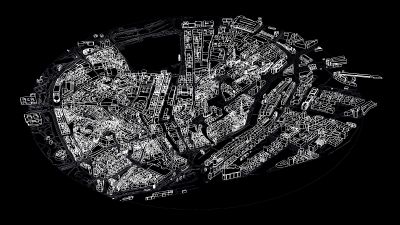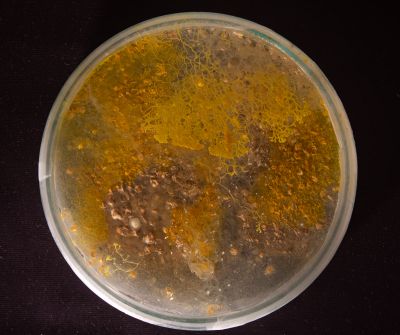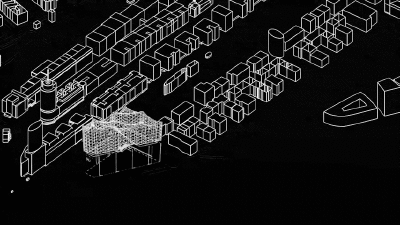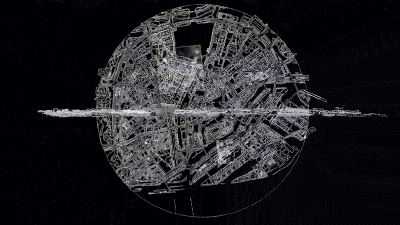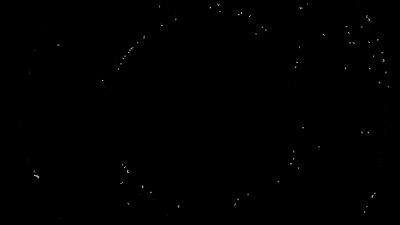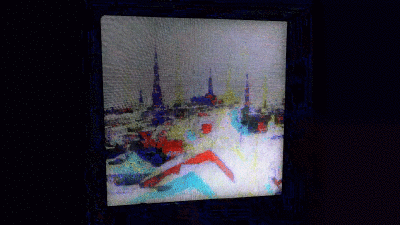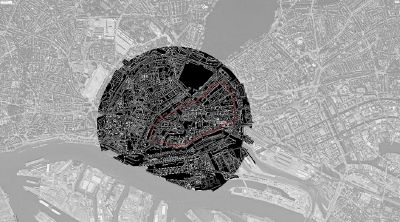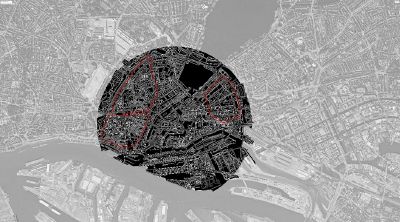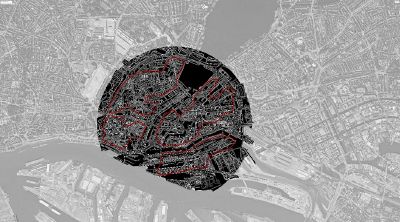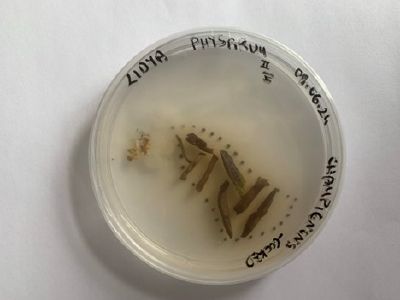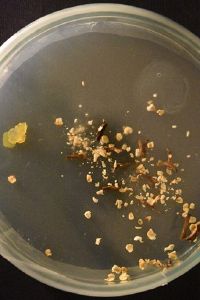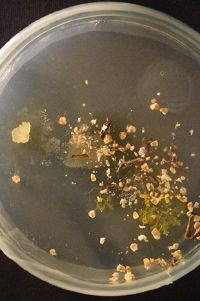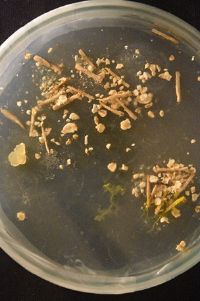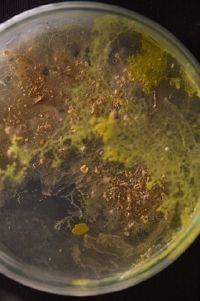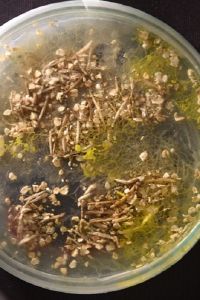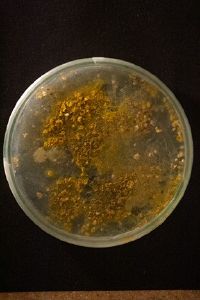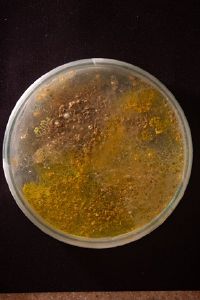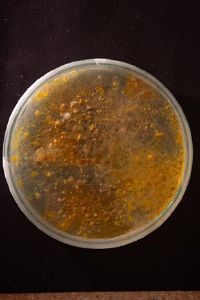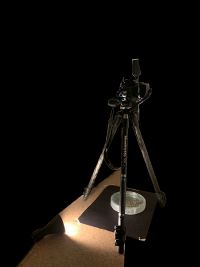BLOB
The video artwork Blob, produced for the "Beyond the Screens" project module under the guidance of Reinhard König for the City Digital Skin Art Festival (CDSA), is a collaborative effort by Amna Chaudhry, Torben Zsagar, and Dicle Lidya Çolak.
The creation of the slime mold installation, specifically the Petri dish setup, was carried out by Dicle Lidya Çolak in the BioLab of the Bauhaus-Universität Weimar. This installation was made possible by the expertise, skills, and equipment gained from the courses "DIY BioLab Driver’s License" and "Growing Microorganisms for Bioart Projects," led by Alessandro Volpato. The project reflects the combined outcomes of the "Growing Microorganisms for Bioart Projects" and "Beyond the Screens" courses.
Abstract
The project Blob explores the themes of rebirth and consumption, advocating for a renewed relationship between humanity and nature to ensure future survival and prosperity. It contrasts the rapid growth fueled by AI and technology with the depletion of resources, warning of an impending collapse. Yet, it also envisions a cyclical rebirth, where the past reappears in the future, encouraging balance between human-made environments and natural ecosystems.
Drawing from climate projections and ancient urban habitats, the project imagines a shift from a human-centered world to one focused on nature, illustrating the natural cycles of growth, decay, and renewal. The design incorporates Physarum polycephalum, a microorganism that occasionally directs the creative process, representing nature’s unpredictability and resilience. The project’s name, Blob, comes from this organism, which plays a central role in the design.
The project centers on the Elbphilharmonie in Hamburg, a landmark merging an old warehouse with a modern glass structure, symbolizing the blend of tradition and innovation needed for sustainable development and a renewed connection with nature. Ultimately, Blob speculates on how architecture and media design can help create a harmonious future between humanity and the natural world.
Table of Contents
- Introduction
1.1 Background and Context
1.2 Objectives of the Project
1.3 Architectural Context of the Project
2. Project Overview / Storyline
2.1. Conceptual framework
2.2. Narrative structure
■ Birth
■ Exploration
■ Undefined
■ Dead End
2.3. Key themes and messages
3. Petri dish installation
3.1 Method
3.2 Shooting for 3 weeks of growth
3.3 Timelapse
4. Design Process
4.1 Ideation
4.2 Inspiration
- Introduction
1.1 Background and Context
“The "Beyond the Screens" project module explores the potential of large-scale urban screens and media facades as platforms for visualizing ecological processes, aiming to make climate change tangible, visible, and experiential in public spaces. The project challenges the anthropocentric viewpoint by asking how we can design environments that recognize the needs and dynamics of non-human organisms, extending beyond human understanding and interests. By mapping, tracking, and narrating interactions within urban ecologies, the project seeks to give a voice to beyond-human species, using digital screens and media architecture to bridge the gap between art, science, and technology.”
For our investigation, an environment was prepared for Physarum polycephalum—commonly known as "Blob"—a microscopic organism frequently used in bioart due to its similarities to human social behavior. This experiment allowed Blob to rediscover the city of Hamburg, where the selected screen is located. By viewing the city through the perspective of a non-human actor, we aimed to examine its past and future, moving beyond the human-centered transformations that have shaped Hamburg over time.
1.2 Objectives of the Project
The project aims to explore how urban screens can serve as ecological visualization zones, making climate change perceptible and experiential to the public. By engaging a non-human actor like Blob, the project seeks to reimagine urban environments, highlighting the often-overlooked dynamics of non-human organisms. Our goal is to create a narrative that informs and inspires a re-evaluation of humanity's relationship with the natural world, fostering greater public awareness at the crossroads of art, science, and technology.
In order to make the artwork more impactful, we chose to maintain a strong connection to the city context. Our intention was for participants to engage with a work that directly reflects the location they are in, as they view it on the screen. To achieve this, we analyzed the historical development of Hamburg within the region surrounding the Elbphilharmonie building. Blob follows the city’s growth along a historical timeline and, at a certain point, begins to determine how the city will evolve in the future.
Man-Made Cubic Structures / Human vs. Nature / Survival of the Fittest
Organic Folding Evolving Structures / Human with Nature / Coevolution
2. Project Overview / Storyline
2.1. Conceptual Framework
The Blob project is rooted in the exploration of humanity's relationship with nature, particularly focusing on themes of rebirth, consumption, and the cyclical nature of life. By replacing the human actor with Physarum polycephalum (Blob), the project shifts the narrative from a human-centered perspective to one that considers the agency and behavior of a non-human organism. The Elbphilharmonie in Hamburg, a symbol of architectural evolution and adaptation, serves as the starting point for this exploration. Through Blob’s movements and interactions within the city, the project reveals how urban environments can be understood and shaped by non-human actors, challenging conventional design practices and encouraging a rethinking of human impact on nature.
2.2. Narrative Structure
Birth:
The storyline begins with the emergence of Blob, replacing the human as the central actor. Starting from the Elbphilharmonie building, Blob begins to spread across the city of Hamburg, mirroring its natural growth patterns observed in Petri dish experiments. This initial phase symbolizes the birth of a new perspective, where the city is viewed through the eyes of a non-human organism.
Content made by: Torben Zsagar & Dicle Lidya Çolak
Editing made by: Amna Chaudhry
Exploration:
In the next phase, a timelapse of a three-week-old Petri dish growth overlaps with a map of Hamburg, illustrating Blob’s exploration of the city. The Blob’s movements are tracked, revealing how it navigates, splits, congregates, consumes, and moves through different areas. This exploration phase highlights the organic, unpredictable nature of Blob's behavior, drawing parallels to how ecosystems evolve and adapt.
Content made by: Torben Zsagar & Dicle Lidya Çolak
Editing made by: Amna Chaudhry
Undefined:
Content made by: Torben Zsagar
Editing made by: Amna Chaudhry
As Blob continues to move, it leaves traces of itself behind, marking these points as memories. These traces signify areas that are no longer suitable for the Blob, preventing it from revisiting them. However, in leaving these marks, Blob disrupts the environment, transforming the texture of the city. The familiar pattern of Hamburg becomes undefined, symbolizing the dissolution of human-centric urban structures and the emergence of a new, undefined landscape shaped by non-human agency.
Dead End:
Content made by: Dicle Lidya Çolak
Editing made by: Amna Chaudhry
The final phase follows Blob’s ongoing journey through the city, guided by the actual movements recorded in the timelapse of the Petri dish installation.
As it moves, Blob encounters challenges, undergoes transformations, and occasionally retreats to new areas, only to repeat the cycle. This phase reflects the cyclical nature of life, where growth and decay are intertwined, and where the search for a sustainable future is ongoing but fraught with obstacles.
2.3. Key Themes and Messages
Rebirth and Transformation: The project emphasizes the need for humanity to rethink its relationship with nature. By replacing the human with Blob, the project illustrates how urban environments might evolve if guided by non-human perspectives. The transformation of the city into an undefined space speaks to the possibility of rebirth and the potential for a more harmonious coexistence between human-made and natural environments.
Nature of Life: The narrative highlights the cyclical process of growth, consumption, decay, and rebirth. Blob’s journey through Hamburg serves as a metaphor for this cycle, illustrating how ecosystems and urban environments are in a constant state of flux.
Non-Human Agency: By focusing on Blob, the project challenges the anthropocentric view that has dominated urban design and development. It calls attention to the importance of considering non-human actors in shaping the future of our cities, advocating for a more inclusive and sustainable approach to design.
3. Petri dish installation
3.1 Method
To enable the Blob to replicate the historical growth of Hamburg up to the present day, we began by analyzing the city’s population density distribution from its earliest settlement to the present. Understanding how Hamburg had developed over time was crucial for guiding the Blob's growth and enabling it to simulate potential future expansion.
To achieve this, extensive historical research was conducted, focusing on the city’s development. Based on this research, we selected three key maps representing Hamburg in 1300, 1892, and 2018, which provided data on the population density distribution across different eras.
These maps were then used to mark the development of the selected area in Hamburg on a city plan. The diagrams derived from this plan were first scaled to match the control group petri dishes (10 cm diameter) and then adjusted for the petri dish used in the timelapse photography (20 cm diameter). This method allowed us to guide the Blob’s growth in a way that mirrored Hamburg’s historical evolution, ensuring that the experiment was both visually and conceptually aligned with the project’s objectives.
diagram based on 1300’s map
diagram based on 1892’s map
diagram based on 2018’s map
first control group petri dish, based on 1300’s map diagram
Growing the Blob According to Historical Data
Step 1 - Initial Placement: The Blob was initially placed on the site representing the Elbphilharmonie building in the petri dish. To simulate the settlement depicted in the first diagram, dating back to the 1300s, food sources were strategically positioned to help orient and sustain the Blob’s growth.
Step 2 - Two Days of Growth: Over the course of two days, the Blob fully explored the designated settlement area, effectively replicating the development of Hamburg up to the 1300s.
Step 3 - First Food Replacement: To simulate Hamburg’s growth between 1300 and 1892, a second set of food sources was introduced in the laboratory. This placement followed the population density diagram from the 1892 map.
Step 4 - Eight Days of Growth: Within eight days, the Blob expanded to cover the areas corresponding to the population density of Hamburg in 1892.
Step 5 - Second Food Replacement: The final set of food sources was introduced based on the dense urban fabric map from 2018, representing the present-day population distribution of Hamburg.
Step 6 - Sixteen Days of Growth: At this stage, the Blob was no longer guided by external intervention. Instead, it was left to determine the future overpopulation and consumption scenario of the city on its own. The experiment continued until the 16th day, when the Blob began to weaken due to stress, marking the end of the timelapse.
11 days of growth
14 days of growth
16 days of growth
3.2 Shooting for 3 weeks of growth
The process of cultivating the Blob required careful attention and time to ensure strong and visible growth. Over three weeks, photos were taken every 15 minutes to document the Blob's growth. The project aimed to align the Blob’s growth with a symbolic timeline reflecting Hamburg’s historical expansion from the 1300s to the present. This approach allowed the Blob’s growth pattern to mimic the city’s development, adding a deeper layer of meaning to the visual narrative. However, the process was not without challenges, as the risk of contamination could lead to mold formation in the Petri dish, potentially compromising the results.
3.3 Timelapse
After capturing the images over the three-week period, Adobe Lightroom was used to compile and organize the photos. This phase was crucial in preparing the raw visual data for further refinement. The next step involved using Adobe Premiere, where contrast and overlap adjustments were made to enhance the visuals and ensure consistency across the sequence. These adjustments were necessary to prepare the images for final processing in TouchDesigner, where the visual narrative of the Blob’s growth would be fully realized.
https://www.youtube.com/watch?v=X7vDehMDgdI
https://www.youtube.com/watch?v=PJEMDSNxfdg
4. Design Process
4.1 Ideation
"Future in a Petri Dish": The project's ideation began with the concept of using primitive organisms like Physarum polycephalum to explore how a non-human perspective could influence urban development. The idea was to allow these creatures, which act purely on instinct, to process environmental inputs and take action in a way unclouded by human ego. The steps involved in this process were:
- Contextual Analysis: Collecting and analyzing data related to the city’s characteristics, including weather, population density, and sociological connections.
- Coding the Environment: Adapting this data into a simplified form that can be translated into a suitable environment for the petri dish, essentially creating a “micro-conceptual city” for the Blob.
- Microbial Growth: Allowing the Blob to build and develop within this micro-city, observing its natural behavior and growth patterns.
- Observation: Monitoring the Blob’s progress using microscopes and installed cameras.
- Decoding Visuals: Translating the Blob’s growth patterns back into the real city’s image, reversing the initial coding process to inform urban design.
- Visualization: Exploring the duality between natural micro-scale growth and artificial macro-scale urban development, potentially highlighting the contrasts through visual glitches.
This approach seeks to minimize human influence and empower non-human actors in shaping urban environments.
4.2 Inspiration
"Man-Nahāta" by Neri Oxman: The project draws significant inspiration from Neri Oxman’s Man-Nahata, a visionary exploration of the synergy between Manhattan’s cultural diversity and Mannahatta’s natural ecosystems. Oxman’s work proposes a future where urban and natural environments are balanced harmoniously, transitioning from a human-centric to a nature-centric landscape.
Man-Nahata imagines the year 2100, where climate change necessitates a re-balancing of the landscape and its inhabitants. The project introduces a circular system where four essential elements—shelter, nutrients, energy, and society—self-organize, integrating human and natural systems.3
The parallels between Man-Nahata and Blob lie in the shared theme of rebalancing human influence with natural growth. Both projects aim to create harmony between built environments and organic processes, proposing that future urban development must integrate and respond to ecological systems. By allowing Physarum polycephalum to influence the design, the Blob project echoes Oxman’s vision of a distributed, nature-centric urban landscape.
